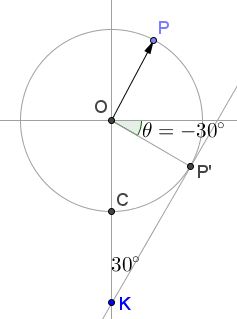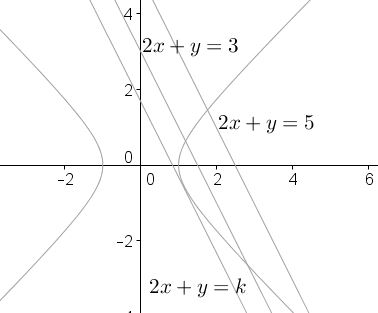An Inequality in Parallelogram of Unit Area
Problem

Solution 1
Define $A=\displaystyle\begin{pmatrix}a&c\\b&d\end{pmatrix}.\;$ Then $\det A=1,\;$ and so too $\det (A^tA)=1.\;$ But
$\displaystyle A^tA=\begin{pmatrix}a^2+b^2&ac+bd\\ac+bd&c^2+d^2\end{pmatrix},$
such that $(a^2+b^2)(c^2+d^2)=1+(ac+bd)^2,\;$ or $\sqrt{(a^2+b^2)(c^2+d^2)}=\sqrt{1+(ac+bd)^2}.\;$
Let $ac+bd=x.\;$ Then by the AM-GM inequality, $a^2+b^2+c^2+d^2\ge 2\sqrt{1+x^2}.\;$ Suffice it to show that $2\sqrt{1+x^2}+x\ge\sqrt{3}.$
If $x\gt\sqrt{3},\;$ there is nothing to prove. Else, if $x\le\sqrt{3},\;$ then the required inequality becomes have $(x\sqrt{3}+1)^2\ge 0,\;$ which is obviously true.
Note that the expression $|ad-bc|\;$ gives the area of the parallelogram build on vectors $\begin{pmatrix}a\\b\end{pmatrix}\;$ and $\begin{pmatrix}c\\d\end{pmatrix}.$
Solution 2
Let $\overrightarrow{OA}=\left(\begin{array}\,a\\b\end{array}\right),\;$ $\overrightarrow{OB}=\left(\begin{array}\,c\\d\end{array}\right).\;$
Then, say,$\begin{align} T &= a^2+b^2+c^2+d^2+ac+bd\\ &= |\overrightarrow{OA}|^2+|\overrightarrow{OB}|^2+\overrightarrow{OA}\cdot \overrightarrow{OB}\\ &\ge 2|\overrightarrow{OA}||\overrightarrow{OB}|+\overrightarrow{OA}\cdot\overrightarrow{OB}, \end{align}$
where the dot $\cdot\;$ denotes the scalar (dot) product. Let $U\;$ denotes the latter expression: $U=2|\overrightarrow{OA}||\overrightarrow{OB}|+\overrightarrow{OA}\cdot\overrightarrow{OB}.\;$ $T\ge U.$
On the other hand, $|ad-bc|=2[\Delta OAB],\;$ i.e., twice the area of $\Delta OAB,\;$ or the area of the parallelogram build on two vectors, $\overrightarrow{OA}\;$ and $\overrightarrow{OB}.\;$ It is easy to check that
$|ad-bc|^2=|\overrightarrow{OA}|^2|\overrightarrow{OB}|^2-\left(\overrightarrow{OA}\cdot\overrightarrow{OB}\right)^2,$
such that
$1+\left(\overrightarrow{OA}\cdot\overrightarrow{OB}\right)^2=|\overrightarrow{OA}|^2|\overrightarrow{OB}|^2,$
We can find angle $\theta\in\displaystyle\left(-\frac{\pi}{2},\frac{\pi}{2}\right)\;$ such that $\tan\theta=\overrightarrow{OA}\cdot\overrightarrow{OB}.\;$ Then $\displaystyle |\overrightarrow{OA}||\overrightarrow{OB}|=\frac{1}{\cos\theta},\;$ reducing $U\;$ to a function of $\theta:$
$\displaystyle U=U(\theta)=\frac{2}{\cos\theta}+\tan\theta.$
Since $\displaystyle U'(\theta)=\frac{2\sin\theta+1}{\cos^2\theta},\;$ the function has local minimum when $\sin\theta=-\frac{1}{2},\;$ i.e., when $\theta=\displaystyle -\frac{\pi}{6}.$
Kunihiko Chikaya has presented a beautiful geometric argument to support his answer. The expression $\displaystyle\frac{2}{\cos\theta}+\tan\theta,\;$ if written differently, clearly represents the slope of the line through $K=(0,-2)\;$ and $P(\cos\theta,\sin\theta),\;$ a point on the unit circle. Indeed, $\displaystyle\frac{2}{\cos\theta}+\tan\theta=\frac{\sin\theta-(-2)}{\cos\theta-0}.\;$ The slope of $KP\;$ is the smallest for $P=P'\;$ where $KP'\;$ is tangent to the circle:

Obviously $\displaystyle P'=\left(\frac{\sqrt{3}}{2},-\frac{1}{2}\right)=\left(\cos (-\frac{\pi}{6}),\sin (-\frac{\pi}{6})\right).$
Solution 3
As in Solution 2, we reduce the problem to another:
Find the minimum of $U=2|\overrightarrow{OA}||\overrightarrow{OB}|+\overrightarrow{OA}\cdot\overrightarrow{OB},\;$ subject to
$1+\left(\overrightarrow{OA}\cdot\overrightarrow{OB}\right)^2=|\overrightarrow{OA}|^2|\overrightarrow{OB}|^2,$
Introduce $x=|\overrightarrow{OA}||\overrightarrow{OB}|\;$ $y=\overrightarrow{OA}\cdot\overrightarrow{OB}.\;$ In terms of $x\;$ and $y\;$ the problem becomes
Find the minimum of $U(x,y)=2x+y,\;$ subject to $x\ge 0\;$ and
$1+y^2=x^2.$
This is equivalent to finding the tangent to the hyperbola $1=x^2-y^2\;$ of the form $2x+y=const.\;$ If $\min U=k,\;$ then, with $2x+y=k,\;$ we obtain a quadratic equation in $x:\;$ $3x^2-4kx+(k^2+1)=0.\;$

For $k,\;$ this quadratic equation needs to have a unique solution, so that its discriminant ought to vanish: $(2k)^2-3(k^2+1)=0,\;$ wherefrom $k=\sqrt{3},\;$ since $k=-\sqrt{3}\;$ corresponds to the tangent to the other branch of the hyperbola where $x\lt 0.$
Solution 4
Solution 3 could be branched into an application of the Lagrange multipliers by setting, say,
$U(x,y,\lambda) = 2x+y+\lambda(1+y^2-x^2).$
We have a system of equations with partial derivatives:
$\begin{align} U_x &= 2-2\lambda x = 0\\ U_y &= 1 + 2\lambda y = 0\\ U_{\lambda} &= 1+y^2-x^2=0. \end{align}$
Expressing $x\;$ and $y\;$ from the first two equations, $\displaystyle x=\frac{1}{\lambda}\;$ and $\displaystyle y=-\frac{1}{2\lambda},\;$ and substituting them into the third we find $\displaystyle\lambda^2=\frac{3}{4}.\;$ To have $x\;$ positive, we choose $\displaystyle\lambda=\frac{\sqrt{3}}{2}.\;$ For this $\lambda,\;$ $2x+y=\sqrt{3}.$
Solution 5
Set $\overrightarrow{u}=\begin{pmatrix}a\\b\end{pmatrix}\;$ and $\overrightarrow{v}=\begin{pmatrix}c\\d\end{pmatrix},\;$ with $ad-bc=1.$
Rotating $\overrightarrow{u}\;$ amd $\overrightarrow{v}\;$ together does not change the value of
$\begin{align}f(\overrightarrow{u},\overrightarrow{v})&=a^2+b^2+c^2+d^2+ac+bd\\ &=||\overrightarrow{u}||^2+||\overrightarrow{v}||^2+\overrightarrow{u}\cdot\overrightarrow{v}, \end{align}$
nor the condition $ad-bc=1.\;$ Hence, WLOG, we can suppose that $\overrightarrow{u}\;$ is along the $x-\text{axis},\;$ that is $b=0.\;$ The expression of $f\;$ then takes a simple form:
$\displaystyle f(\overrightarrow{u},\overrightarrow{v})=a^2+c^2+\frac{1}{a^2}+ac=P_a(c).$
Since $P_a(X)=X^2+aX+a^2+\displaystyle\frac{1}{a^2}\;$ is a polynomial of degree 2 with positive leading coefficient, it admits a global minimum at $\displaystyle -\frac{a}{2},\;$ that is, for every $x\in\mathbb{R},$
$\displaystyle p_a(x)\ge P_a(-\frac{a}{2})=\frac{3a^2}{4}+\frac{1}{a^2}.$
We now apply the AM-GM inequality:
$\displaystyle \frac{3a^2}{4}+\frac{1}{a^2}\ge 2\sqrt{\frac{3}{4}}=\sqrt{3}.$
Solution 6
By the AM-GM inequality, and t hen using the Lagrange identity
$\begin{align} (a^2+b^2)+(c^2+d^2) &\ge 2\sqrt((a^2+b^2)(c^2+d^2))\\ &=2\sqrt{(ac+bd)^2+(ad-bc)^2}\\ &=2\sqrt{(ac+bd)^2+1}. \end{align}$
It follows that
$a^2+b^2+c^2+d^2+ac+bd\ge 2\sqrt{(ac+bd)^2+1}+ac+bd.$
This, suffice it to prove that
$2\sqrt{(ac+bd)^2+1}+ac+bd\ge\sqrt{3}.$
But the latter is equivalent to
This, suffice it to prove that
(*)
$2\sqrt{(ac+bd)^2+1}\ge\sqrt{3}-{ac+bd}.$
Now, if $ac+bd\ge\sqrt{3},\;$ then (*) is obvious. So assume $ac+bd\lt\sqrt{3}.\;$ In this case, (*) is equivalent to
$\left[2\sqrt{(ac+bd)^2+1}\right]^2\ge\left[\sqrt{3}-(ac+bd)\right]^2.$
To continue,
$4\left[(ac+bd)^2+1\right]\ge\left[3+(ac+bd)^2-2\sqrt{3}(ac+bd)\right].$
And then
$3(ac+bd)^2+1-2\sqrt{3}(ac+bd)\ge 0,$
which is simply
$\left[\sqrt{3}(ac+bd)-1\right]^2\ge 0,$
and this is certainly true.
Acknowledgment
Leo Giugiuc has kindly posted the problem and his solution (Solution 1) at the CuTheKnotMath facebook page, with a link to a mathematical inequalities facebook group. Following the link, I found that the problem has been posted much earlier, at which time Kunihiko Chikaya replied with a solution of his own, giving credit for the problem to Alim Eyvazov. I took the liberty to include his solution (Solution 2) in a slightly modified form. Kunihiko Chikaya then sent Solution 3 in a private message. Solution 5 has been posted on twitter.com by Lynx Myope; Solution 6 by Vaggelis Stamadiadis was pointed to by Kunihiko Chikaya.
Related material
| |
Linear Algebra Tools for Proving Inequalities$\;\left(\displaystyle\left(\frac{a}{b-c}\right)^2+\left(\frac{b}{c-a}\right)^2+\left(\frac{c}{a-b}\right)^2\ge 2\right)$ | |
|
| |
|
| |
|
| |
|
| |
|
| |
|
| |
|
| |
|
| |
|
| |
|
| |
|
| |
![]()
|Contact| |Front page| |Contents| |Algebra|
Copyright © 1996-2018 Alexander Bogomolny73581883
